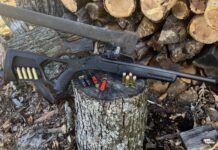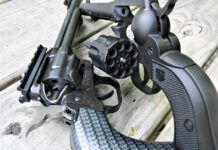You cannot open a publication that specializes in gun sales without seeing an advertisement for a Lee Enfield rifle, especially the #4 MK1. This gun is one of the most common bolt-action rifles in the world, but it is also a little confusing because it looks so much like the #1 MK III.
Those two rifles may look alike, but they are not the same and their parts do not interchange. For our purposes here, we’ll deal with the full military #4 MK1 because cutdown and sporterized versions are going to vary depending on who did the work.
That confusion between the two Enfield versions shows up almost from the start. If your rifle has feeding problems, make sure the magazine is the right one. People often try to put #1 MK III magazines into the #4 MK 1. The correct magazine has a locking lug on the rear of its body, made up of a wedge-shaped piece that runs less than halfway to the base.
The MK III locking lug resembles a “saw tooth” and extends almost to the bottom of its magazine.
As if the basic confusion isn’t enough, these magazines have also been worked on in every way the human mind can conceive. Anything you have ever seen done to a magazine has been tried on Enfield magazines. If yours looks like it was the target for every shell to hit the beach on D-Day, it may be beyond repair, but many of these old magazines work satisfactorily despite years of use and abuse.
The magazine probably is salvageable if it locks in tightly and releases smoothly. You can make the rest work correctly. If the shell follower moves up and down without hanging or sticking, then the only work that may be needed is proper alignment of the feed lips. If the follower does stick, check the magazine to see if it is dented or pressed in on one or both sides. This can be fixed, too. Depress the rear while leaving the front portion of the cartridge carrier up, work the front from the body and remove it along with the spring. You can now beat the dents out or return the sides to their original position but if you do too much, the magazine will no longer fit into the rifle. Check the fit before you put the spring and carrier back in, making sure the magazine slides in and out correctly. Check again after you’ve re-installed the two pieces.
The magazine’s lips must be identical and smooth on both sides. Waves, sharp edges, burrs or other visible defects should be taken care of before attempting any other work. Charge the magazine with five or six .303 rounds then push two out by hand to see that they slide out freely. If they drag or hang, smooth out the problem area.
Now insert the magazine and work the bolt. The bolt face should grab at least 3 millimeters of the rimmed .303 cartridge. The round should also lie so its top edge is nearly flat against the closed bolt; neither the front nor back of the cartridge should be neither too high or too low.
The bullet nose must be postured high enough to slide into the chamber when the bolt closes. If everything is okay to this point, load all 10 rounds and try chambering each of them. If they did, nothing else is required. Don’t mess with success.
Consider the symptoms if the rifle still won’t feed. See if the cartridge is lying flat as we described above. Don’t consider the raised rim at this point. If the back isn’t coming up enough, the rear lip must be opened a little to permit the round to ride higher.
Do this one side at a time, taking it slow and easy, because many of these old magazines have been adjusted too many times already and the metal is weak. Both sides should allow the cartridge rim to come up to the same height. Now check the front feed lips, making sure the bullet nose is aligned to the chamber on both sides as the cartridges alternate side-to-side while coming out of the staggered magazine. If they are too open, the cartridges will prematurely come loose and the loose cartridge will jam the rifle. If the lips are too closed, the cartridge will not release early enough to feed. Again, make your adjustments a little bit at a time and remember that working on 50-year-old magazines is a matter of trying and trying again.
Ordering replacement magazines is just about as iffy as working on them. You may or may not get the right one, and the one you get may be worse than the one you’re trying to fix. One of my parts suppliers called last year, saying his firm had just located some new British surplus magazines and asked how many I wanted. He couldn’t say if they were #1s or #4s, but he knew they were still in their British wrapping. To make my point, these new magazines turned out to be used, rejected by the British army as “nonfunctional.” In other words, they were high-priced garbage.
Extraction problems can be directly traced to either the extractor or chamber. Literally hundreds of thousands of these rifles have bounced around Third World countries for the last 50 years, so many of the barrels are in terrible shape. Inevitably, people will scrub the bores until they are bright and shiny but do nothing to get the chamber clean. The problem is, these rifles must have clean and rust-free chambers to extract properly.
When a rifle extracts live ammo every time but will not extract fired brass, you can lay odds on its having a bad chamber. When the chamber cannot be cleaned up or is rusted out, the only answer is a new barrel.
Replacements for broken extractors and extractor springs are easily located as many companies keep the parts in stock. Getting the right one is sometimes not as easy, so be sure you give the supplier all the right information.
Then it will be his fault when the wrong part is shipped.
Now let’s go through the procedures for removing the #4’s bolt. The first step is to lift the long-range rear sight that hinges down into the top of the receiver to its “up” position. The bolt won’t come out of or go back into the receiver unless it is raised. Draw the bolt fully open, then push it forward 1 inch. The bolt release is located an inch behind the stripper clip guide, just above the wood on the bolt side.
Press it down as far as it will go and pull the bolt all the way back again. Holding the bolt release down, rotate the bolt head up into the receiver and let the bolt release go. The bolt will now slide out of the rifle.
The extractor face should be at a 45-degree angle to the face of the bolt head. It should have a slightly concave face and the claw should be sharp. It was not grooved originally but, after years of use, most of them are anyway. As long as the claw edge is sharp and doesn’t have chips of metal missing, these grooves have no effect on performance. If the extractor itself seems in good condition, the extractor spring may be causing the problem. This is a strong spring and will need to be replaced if it pulls back easily.
Before taking the bolt apart, pull the cocking piece back from the bolt body while twisting its base toward the bolt handle. This will allow the cocking piece to turn into the firing position and allow the firing pin to come about 2 millimeters through the bolt face.
Work the cocking piece back and forth several times to make sure it moves freely and that the firing pin is coming through the bolt face correctly every time. The first 1/2 inch will move very easily, which suggests a weak firing pin spring, but it is designed this way. If it feels stiff, gritty or sticks, it will require cleaning or repair. We will get to that in a moment.
Take out the bolt face by unscrewing it from the bolt body in a counter- clockwise direction. The extractor is secured by a retaining screw that should be removed slowly to avoid damaging the threads as the extractor is released.
The U-shaped extractor spring rarely breaks with use but can be destroyed by attempts to pry it open wider. Trying this will not increase the strength; it will only decrease assuming it doesn’t break.
Sometimes these bolt heads will be so badly rusted that you wouldn’t think they could be saved—I’ve seen some so bad you couldn’t tell where the bolt stopped and the receiver started—but all the parts were usable after soaking and cleaning.
The firing pin can be removed by taking out the firing pin stop screw and unscrewing the cocking piece from the firing pin. If your earlier examination showed that the firing pin assembly is working correctly, the bolt assembly will not be responsible for misfires. Cleaning or repairing/replacing the parts will usually solve the problem. If it doesn’t, then you’ll have to move on to the receiver.
A trapdoor in the Enfield’s buttstock eliminates the necessity of taking off the brass butt plate to remove the stock. A large flat blade screwdriver will unscrew the stock bolt as long as enough pressure is applied and parts are not too rusty.
Many people break their Enfield’s forestock while trying to remove it.
To do it right, three screws that have their heads on the left side of the stock—the rear trigger guard screw, the middle stock band screw, and the front stock band screw—must be taken out first.
Now remove the front trigger guard screw from the bottom of the stock and you can remove the remaining wood from the rifle. The middle stock band can be pulled apart enough to slide it off the top of the rifle. Shims that may be under it to take up the slack caused by many years of hard use must be saved and replaced the way they came out to avoid the reassembled rifle’s having loose wood. Loose wood will also affect the accuracy of the rifle.
Pull the front band apart just enough to let it slide over the metal pins that are holding it in the front then push it as far forward as it will go. Now lift the front end of the rear handguard, where the center barrel band was located, enough to clear the back of the front handguard. Pull it toward the muzzle and it will come out of the rear stock band.
The front handguard will come off when pulled to the rear. At this point, you have to push the front stock band forward enough to get the front end of the forestock to slip from beneath it. By wiggling and pulling forward on the forestock you will be able to work it off the action and barrel. Pry it or force it, and you will have broken wood.
Assuming you find nothing inside the bolt that caused the misfires, let’s check the receiver for the problem before moving on to other items.
While the wood and trigger guard are off the rifle, reinstall the bolt to find out what is hindering the firing. Remember, the long range sight must be in its erect position and the bolt face lug pointed up to match the rib on top of the bolt. Slide it in as far as it will go and turn the bolt head down into its lock. Push the bolt lock down until the bolt head turns enough to slide forward into the receiver and then release the bolt lock lever.
Pull down on the bottom of the sear and work the bolt back and forth to see where the cocking piece is dragging. More than likely, it will be dragging on a improperly fitted safety. The safety, held in place by just one screw, should be removed so you can determine if everything works correctly without it in place. If you are still having problems, you more than likely have the wrong bolt in the rifle.
When the safety is installed in the rifle and in its “off” position, the lug that extends into the receiver where the bolt rides should be smooth enough to let the cocking piece slide through without interference. If you are getting interference, remove the safety and file it to fit but double check to make sure it will still engage correctly after you’re finished.
The one-piece sear and magazine latch spring is the typical British “U” type. The sear is pinned into position. The magazine releases on some early models are by a screw while later versions are pinned. Many of these latches have been filed on to a point that they will not work right and then they’ve been welded on and braised.
The theory seems to be that if something does not work correctly, fix it by grinding off metal.
When that fails, welding a bunch back on is bound to help. If you are rebuilding someone else’s mess, try to get an original replacement magazine latch or at least copy an original to insure a return to its original configuration.
Attempts to improve the trigger on these Enfields have created two other problems that are hard to correct.
The first one was common in the early 50s when thousands of these rifles came into the country, selling for no more than $12.50 apiece and sometimes for less than $10 by mail. Military rifles were not too popular at the time, so most were “sporterized,” which meant little more than being cut down. Long hard military triggers were worked over with little regard for safety and certainly no thought of a lawsuit.
The front edge of the Enfield’s cocking piece is the top sear. As the trigger is pulled, you have to force the firing system back a short distance before the sear releases. That’s very safe, very military but very unpopular. As these were “cheap” guns, no one wanted to spend time doing the job right so some people merely ground the front cocking pieces at an angle so the sear released fast and without extra pull.
However, these ground surfaces smoothed out over the years wear and the rifles started going off all by themselves. Most were simply thrown away or destroyed when they became unsafe back then.
I’d like to say people have gotten smarter about doing things like that but I’d be lying. It’s still done today although the consequences are severe.
A gunsmith friend of mine had a customer bring a sporterized Enfield into his shop for a routine cleaning several years ago. He cleaned and oiled the rifle as requested. He never touched the trigger. The owner took the rifle home for his teenage son.
During a hunting trip the following week, the rifle accidentally discharged in the field, killing the father. The gunsmith said he had nothing to do with the accident but the whole family testified the rifle had never gone off before.
The jury awarded the family a $400,000 judgment against the gunsmith.
He didn’t have insurance—practically none of us did—and lost everything. The moral here is that you should always check the front face of the cocking piece on every Enfield cocking piece you take in. If it has been ground, filed, or otherwise altered, treat it like you would a rattlesnake or politician: Get away fast!
The other popular trigger modification involved grinding off the whole bottom edge to about half its original thickness.
This reduced travel by 65-75 percent of what it had been and cut the pull to less than half the original weight. The problem with this method was the same one created by the first one we described—the rifles will go off on their own.
There is a modification qualified gunsmiths—novices should avoid such work— can make that works very well when done correctly.
Add a small weld bead to the top angle of the sear where it contacts the frame. File it down until it is smooth and to the point where it locks onto the bottom 2 millimeters of the sear face of the cocking piece. You get a smooth trigger pull, a short stroke, and safety all in one. Do not try anything less than a two millimeter latch.
We have already talked about reassembling the bolt and putting it back into the receiver. To get the rest of the gun back together, reverse the disassembly procedure. There are a couple of things you’ll need to remember, though.
First, make sure the rear stock band is in proper position and turned with the thick part up and the thin part down.
Resist the temptation to, as you are struggling to get the front stock band over the end of the forestock, to spread it further. This piece has probably been on and off these rifles so many times the metal is fatigued and easily broken. Just work with it and it will go on.
Even though they may have been on wrong when you got the rifle, the barrel bands should be put back on like they were originally with the screw heads on the left side of the rifle. Pull the trigger forward and make sure it slides in behind the sear before attempting to put in either screw. If the trigger guard does not slide into place with ease, it is not fitting right. Do not attempt to force it or replace either screw in until it does.




























